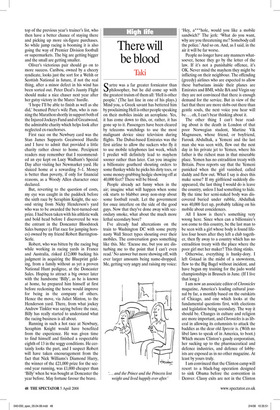Money and mud
Robin Oakley
It would have been nice to be at Nad Al Sheba racecourse last Saturday to see the burly, majestic Curlin obliterate the pretenders to his crown as the best racehorse in the world and saunter away with the Dubai World Cup. We only see quality like that once in a decade.
Instead I was at Newbury, watching mudsplashed jockeys retreating thankfully to the weighing room like fighter pilots after a sortie, and soaking racegoers clustering ineffectually under blown-out umbrellas as the rain drove in from every angle. I was going to remark that it does not take a $20-million card for jumping folk to enjoy themselves. It is the sheer good-fellowship of the winter sport that warms the heart.
But, watching the racing folk queuing to congratulate the ever-approachable Oliver Sherwood after his double on the Newbury card with Caribou in the Ladbrokes Chase and the gutsy top-weight Jaunty Flight in the Mares Only National Hunt Novices’ Hurdle Final, I had to reflect how money is increasingly affecting the winter game too.
Oliver and Tarnya run one of the friendliest of jumping yards. Half a dozen past Cheltenham Festival winners testify to his ability to prepare good horses. But like many others in the upper middle ranks, Oliver has not found it as easy to pick up a string of top races in recent years, thanks simply to racing demographics.
Just before Cheltenham, I discussed with Oliver, for a study in another publication, what you have to spend these days to find a Festival winner. There were, he said, essentially three choices: ‘You can buy an unraced horse, a slow-developing “store horse” bred for jumping and chosen by its physical presence and pedigree, hoping that it will make the grade. You can buy a horse off the Flat that has shown some promise. That’s like buying a second-hand car. It can be good but it’s a hit-and-miss business. (Not all horses who have shown talent on the Flat reproduce it over obstacles.) ‘Finally, you can buy a proven jumper from Ireland or France. But then the next question is: how big is your bank balance? Buying an Irish point-to-pointer that has won any kind of race will nowadays cost you £50,000 to £250,000, and more if it has the right connections.’ With good horses becoming so expensive — the entrants for this year’s Triumph Hurdle probably cost some £10 million between them — the few people able to conjure up the extra noughts are tending to house them only with those at the very top of the previous year’s trainer’s list, who then have a better chance of staying there and picking up more six-figure purchases. So while jump racing is booming it is also going the way of Premier Division football or supermarkets. The big are getting bigger and the small are getting smaller.
Oliver’s victorious pair should go on to more success. Caribou, owned by a cheery syndicate, looks just the sort for a Welsh or Scottish National in future, if not the real thing, after a minor defect in his wind has been sorted out. Peter Deal’s Jaunty Flight should make a nice chaser next year after her gutsy victory in the Mares’ hurdle.
‘I hope I’ll be able to finish as well as she did,’ beamed Peter’s wife Pam, who is running the Marathon shortly in support both of the Injured Jockeys Fund and of Greatwood, the admirable charity which helps look after neglected ex-racehorses.
First race on the Newbury card was the Stan James Supports Greatwood Hurdle and I have to admit that provided a little charity rather closer to home. Percipient readers may remember that I recommended an eye kept on Lucy Wadham’s Special Day after visiting her Newmarket yard. He sluiced home at a rewarding 5–1. Money is better than poverty, if only for financial reasons, as a Woody Allen character once declared.
But, reverting to the question of costs, my eye was caught in the paddock before the sixth race by Seraphim Knight, the second string from Nicky Henderson’s yard who was to be awarded the best-turned-out prize. I had been taken with his athletic walk and bold head before I discovered he was the entrant in the Doncaster Bloodstock Sales bumper (a Flat race for jumping horses) owned by my friend Robert BarringtonSerle.
Robert, who was bitten by the racing bug while working in racing yards in France and Australia, risked £12,000 backing his judgment in acquiring the Blueprint gelding, from a family without as yet a proven National Hunt pedigree, at the Doncaster Sales. Hoping to attract a big owner later with the handsome ‘Billy’, as he is known at home, he prepared him himself at first before reckoning the horse would improve for being in the company of others. Hence the move, via Juliet Minton, to the Henderson yard. There, from what jockey Andrew Tinkler was saying before the race, Billy has really started to understand what the racing business is all about.
Running in such a hot race at Newbury, Seraphim Knight would have benefited from the experience. He was given time to find himself and finished a respectable eighth of 13 in the soggy conditions. He certainly looks the part, and I suspect Robert will have taken encouragement from the fact that Nick Williams’s Diamond Harry, the winner of the £21,000 prize for the second year running, was £1,000 cheaper than ‘Billy’ when he was bought at Doncaster the year before. May fortune favour the brave.



































































 Previous page
Previous page